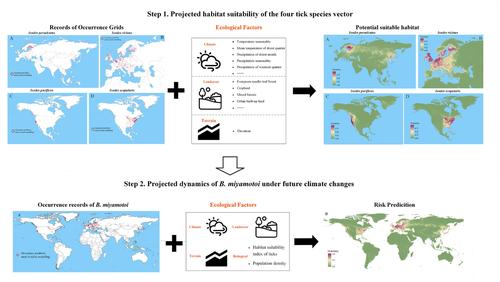当前位置:
X-MOL 学术
›
Environ. Microbiol.
›
论文详情
Our official English website, www.x-mol.net, welcomes your
feedback! (Note: you will need to create a separate account there.)
Global risk dynamics of Borrelia miyamotoi in the context of climate change
Environmental Microbiology ( IF 4.3 ) Pub Date : 2024-10-16 , DOI: 10.1111/1462-2920.70000 Tian Tang, Hong‐Han Ge, Tian Ma, Meng‐meng Hao, Shuai Chen, Chen‐Long Lv, Yun‐Bo Qiu, Yan‐He Wang, Yao Tian, Jin‐Jin Chen, Shuai Yuan, Qian Wang, Dong Jiang, Fang‐Yu Ding, Wei Liu, Li‐Qun Fang
Environmental Microbiology ( IF 4.3 ) Pub Date : 2024-10-16 , DOI: 10.1111/1462-2920.70000 Tian Tang, Hong‐Han Ge, Tian Ma, Meng‐meng Hao, Shuai Chen, Chen‐Long Lv, Yun‐Bo Qiu, Yan‐He Wang, Yao Tian, Jin‐Jin Chen, Shuai Yuan, Qian Wang, Dong Jiang, Fang‐Yu Ding, Wei Liu, Li‐Qun Fang

|
The impact of Borrelia miyamotoi on human health, facilitated by the expanding geographical distribution and increasing population of Ixodes ticks, remains obscure in the context of global climate change. We employed multiple models to evaluate the effect of global climate change on the risk of B. miyamotoi worldwide across various scenarios. The habitat suitability index of four primary vector tick species for B. miyamotoi , including Ixodes persulcatus , Ixodes ricinus, Ixodes pacificus and Ixodes scapularis , was projected using a boosted regression tree model, considering multiple shared socio‐economic pathway scenarios over various time periods. The modelling analysis reveals that, apart from I. scapularis , future global warming will result in a northward shift in the other three vector tick species and a gradual reduction in suitable habitats. Random forest models indicate consistent changes in B. miyamotoi and its primary tick species, with potential risk areas shrinking and shifting northward, particularly in the eastern USA, northeastern and northern Europe and northeast Asia. These findings highlight the urgent need for enhanced active surveillance of B. miyamotoi infection in primary vector tick species across projected potential risk areas. The effect of climate change on B. miyamotoi distribution might have significant implications for public health decision‐making regarding tick‐borne pathogens.
中文翻译:

气候变化背景下宫本疏螺旋体的全球风险动态
在全球气候变化的背景下,宫本疏螺旋体对人类健康的影响,由于硬蜱的地理分布扩大和种群增加而得到促进,仍然不明朗。我们采用多种模型来评估全球气候变化在各种情景下对全球 B. miyamotoi 风险的影响。考虑不同时期的多个共享社会经济途径情景,使用提升回归树模型预测宫本硬蜱的四种主要媒介蜱物种的栖息地适宜性指数,包括沟硬蜱、蓖麻硬蜱、太平洋硬蜱和肩突硬蜱。建模分析显示,除了肩突蜱外,未来的全球变暖将导致其他三种媒介蜱物种向北移动,适宜栖息地逐渐减少。随机森林模型表明 B. miyamotoi 及其主要蜱物种的变化一致,潜在风险区域缩小并向北移动,尤其是在美国东部、东北欧和北欧以及东北亚。这些发现突出了在预计的潜在风险区域加强对主要媒介蜱物种中宫本芽孢杆菌感染的主动监测的迫切需要。气候变化对 B. miyamotoi 分布的影响可能对有关蜱传病原体的公共卫生决策产生重大影响。
更新日期:2024-10-16
中文翻译:

气候变化背景下宫本疏螺旋体的全球风险动态
在全球气候变化的背景下,宫本疏螺旋体对人类健康的影响,由于硬蜱的地理分布扩大和种群增加而得到促进,仍然不明朗。我们采用多种模型来评估全球气候变化在各种情景下对全球 B. miyamotoi 风险的影响。考虑不同时期的多个共享社会经济途径情景,使用提升回归树模型预测宫本硬蜱的四种主要媒介蜱物种的栖息地适宜性指数,包括沟硬蜱、蓖麻硬蜱、太平洋硬蜱和肩突硬蜱。建模分析显示,除了肩突蜱外,未来的全球变暖将导致其他三种媒介蜱物种向北移动,适宜栖息地逐渐减少。随机森林模型表明 B. miyamotoi 及其主要蜱物种的变化一致,潜在风险区域缩小并向北移动,尤其是在美国东部、东北欧和北欧以及东北亚。这些发现突出了在预计的潜在风险区域加强对主要媒介蜱物种中宫本芽孢杆菌感染的主动监测的迫切需要。气候变化对 B. miyamotoi 分布的影响可能对有关蜱传病原体的公共卫生决策产生重大影响。


















































 京公网安备 11010802027423号
京公网安备 11010802027423号